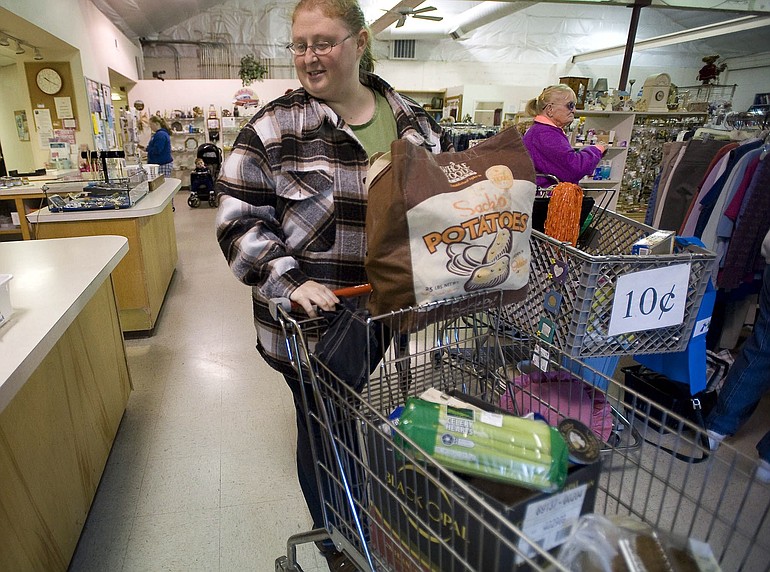Washougal mother Cheryl McGuire made what she said was her first visit Tuesday to the Inter-Faith Treasure House food bank.
She selected a variety of vegetables and other nourishment for her family, which includes a 17-month-old son she describes as a picky eater.
An increasing number of Clark County residents are turning to food banks, as the county finds itself among state leaders in a dismal category: biggest increase of residents living in poverty.
According to a study released this week by the Washington State Budget and Policy Center, Clark shares the unwanted distinction with Grays Harbor, Yakima and Snohomish counties.
Food banks serve people who are at or below 185 percent of federal poverty guidelines ($40,793 for a family of four), and have seen a 25 percent increase in people asking for help, said Pete Munroe, Clark County’s housing and community development manager.
Munroe said his staff has been circulating a needs survey at food banks and shelters, asking low-income residents to rank their top needs.
Out of 450 responses, “food assistance” earned the top spot.
It’s the first time “food assistance” has ranked first, he said.
Dental and health care round out the top three needs, he said.
“Then came employment services, rent assistance, clothing, utilities/heating assistance and then prescription medication,” Munroe said.
The state’s think tank noted that the increasing number of people living in poverty comes during a recession that has caused a dramatic decline in state revenues that in turn threaten or eliminate public services.
“In addition to more than $4 billion in cuts passed the last two legislative sessions, Gov. Chris Gregoire recently called for 6 percent across-the-board cuts, which drastically impact human services that support the growing number of Washington families living in poverty,” according to the press release issued by the policy center.
Clark County has a reported unemployment rate of 13.3 percent, the highest in the state.
From 2008 to ’09, the number of children living in poverty in Clark County increased by 4.4 percent, behind Grays Harbor County’s 7.6 percent and Yakima County’s 6.3 percent, according to the study.
Clark County also ranked behind Grays Harbor and Yakima counties in terms of the increase of total people living in poverty, with a 2.2 increase.
According to the U.S. Census Bureau, 9.9 percent of Clark County’s population was living at or below the federal poverty level in 2008, compared to 11.3 percent of people statewide.
Munroe said he has seen an increase in married couples with children younger than 18 seeking help, as well as an increase in single fathers. Single mothers account for 44 percent of the families who qualify for assistance, he said.
“I think we’re at the bottom, but I don’t think there’s going to be a fast increase. I think we’ll be at the bottom for awhile, until the unemployment rate starts going down,” Munroe said.
Some of his surveys came back with written comments, including one from a young woman who wrote that she had recently left an abusive partner and it was difficult for her to accept that she needed help. “It’s been a tough month,” she wrote. “I’m thankful for the resources I’ve been given.”
Health care a luxury
Carrie Vanzant, director of SeaMar’s two Vancouver medical clinics, didn’t need a state study to tell her about increasing demand for low-income resources in Clark County.
“Just last week we saw 475 patients,” Vanzant said. One clinic has 16 exam rooms, the other has 10.
Clients pay on a sliding scale, depending on family size and income. The clinic relies on federal and state funding.
“I have stuffed both my clinics full of providers and support staff, so that we can see as many people as we can see,” she said. “Right now, I’m just out of building space.”
While doctors at the clinic encourage primary care and preventative care, they often see people who are coming in as a last resort.
“Health care for the majority of patients we see is a luxury,” Vanzant said.
She has opened up an urgent care clinic and a Saturday clinic and expanded weekday hours.
In 2009, the two SeaMar clinics treated 514 patients ages newborn to 4; 1,025 patients ages 5 to 12; 876 patients ages 13 to 19; 5,383 patients ages 20 to 44; 3,699 patients ages 45 to 64 and 926 patients age 65 and older. Those patients accounted for 27,000 office visits, as many came in more than once.
The 2009 numbers reflected a 24 percent increase from ‘08.
She said 49 percent of the patients had no health insurance.
Apart from trying to see as many patients as possible, a major challenge has been finding specialists who will take referrals. She said she has problems finding cardiologists, neurologists and gastroenterologists.
“They won’t take our patients,” she said. “We do everything we can in primary care.” For specialists, the patients “often end up in the emergency room, where the specialists have no choice but to see them,” Vanzant said.
Munroe, of the county’s Community Services department, said he was mildly surprised to hear that Clark County ranked as high as it did in the state study.
“I felt that there were other counties that might go up faster with the poverty rate,” Munroe said. “It’s becoming a greater gap between the haves and the have-nots.”
Stephanie Rice: 360-735-4508 or stephanie.rice@columbian.com.



